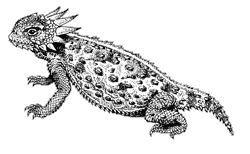Horned Lizards
(Phrynosoma spp.)
Order: Squamata
Family: Iguanidae (iguanid lizards)
Other common names: horny toad
Spanish name: camaleón
Distinguishing Features
Up to 10 species of horned lizards occur in the Sonoran Desert region, from the 2¾ inch (69 mm) long round-tailed horned lizard (P. modestum) to the 5 inch (127 mm) long Texas horned lizard (P. cornutum). With squat, flat, toad-like bodies (Phrynosoma means “toad-body”) and thorn-like projections at the rear of their heads, horned lizards are easily distinguished from other lizards. The projections differ in size and arrangement from one species to another. Along the sides of the body, fringe-like scales occur in one row, two parallel rows, or they may be absent. Males have enlarged post-anal scales, and during the breeding season, a swollen tail base.
Range
 |
Horned lizards are found throughout the Sonoran Desert region from near sea level up to 11,300 feet (3440 m). Some species are widespread, such as the round-tailed and Texas horned lizards which occur in several U.S. and Mexican states, while the flat-tailed horned lizard (P. mcalli) is restricted to southwestern Arizona, extreme southeastern California, a small part of northeastern Baja California and the upper neck of northwestern Sonora, Mexico.
Habitat
Horned lizards are found in extremely diverse habitats. The flat-tailed horned lizard occurs in areas of fine sand, while the short-horned lizard (P. douglassii) is found in shortgrass prairie all the way up into spruce-fir forest. The most common species in the Arizona Upland subdivision is the regal horned lizard (P. solare), which frequents rocky or gravelly habitats of arid to semiarid plains, hills and lower mountain slopes.
Life History
The diet of some horned lizards consists of specific insects, while other species are more catholic in their tastes. Not only does P. solare prefer ants, it has a strong preference for harvester ants, which may make up to 90 percent of its diet. As diets go, ants are low return items because so much of their body consists of indigestible chitin. Thus, the regal horned lizard must eat a great number of ants to meet its nutritional needs. This diet requires space, which is why the stomach of the regal horned lizard may represent up to 13 percent of its body mass.
Ant-eating horned lizards usually capture their prey with their sticky tongues rather than grabbing it with their jaws. In addition, they have modified skeletal morphologies, such as shorter teeth and reduced diameter of the bones of the lower mandible.
Horned lizards are no exception to the general rule that lizards are not attracted to dead insects as food—the ants must be alive and moving for the lizard to show interest in them as prey. Harvester ants can bite and have a potent venom, but apparently this has little effect on the esophagus or stomach of the lizard. However, when faced with swarming ants the lizard will make a hasty retreat, for these little invertebrates can kill an adult horned lizard.
Most species of horned lizards lay eggs between May and August, with clutches ranging from 3 to 45 depending on species. Even with such high numbers of eggs only around 2 from each clutch will reach sexual maturity. The short-horned lizard bears live young. This is considered an adaptation to living at higher elevations, where eggs may be at risk due to low temperatures, and egg development might be slowed considerably.
Comments
The body form and armor of the horned lizard cost it speed and mobil-ity, but they confer great advantages as well. Small animals, such as snakes, have more difficulty with a horned lizard’s wide, thorny body than with a smooth, slender lizard. In fact, when confronted by a snake, a horned lizard will continually present the largest part of its body to the snake. Some horned lizards are difficult to distinguish from rocks; thus they avoid detection by would-be predators. In response to a threat, a horned lizard may play dead, or it may run away and then suddenly turn around to face its attacker, hissing or vibrating its tail in leaf litter. Several species can rupture small capillaries around their eyes and squirt a bloody solution at would-be predators. These fluids, beyond coming as a surprise, can be irritating to the mucous membranes of some predators.
The large, flat body surface of the horned lizard also works well as a solar collecting panel: at cooler temperatures, the lizard will orient its body to maximize the amount of exposure to the sun. When it gets too hot, the horned lizard will burrow into loose soil. Initially, the lizard uses the scales on the front edge of its lower jaw to literally cut into the earth as it vibrates its head into the ground. Then it will shake and shimmy its body into the soil until almost none of it is above the surface.